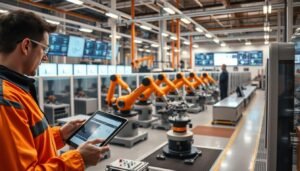Data science is reshaping the way businesses operate, especially in the retail sector. By leveraging advanced analytics, companies can now make smarter decisions that drive growth and efficiency. This transformation is not just about numbers; it’s about understanding consumer behavior and tailoring strategies to meet their needs.
In the past, retail operations relied heavily on intuition and traditional methods. Today, data science provides a solid ground for predicting market trends, optimizing inventory, and enhancing the customer experience. From cloud-based POS systems to real-time inventory analytics, technology is at the forefront of this evolution.
One of the key differences between retail and wholesale is the direct engagement with consumers. Data science helps businesses track sales, cash flow, and profit margins more accurately. This level of insight allows retailers to stay competitive in a fast-paced market.
As we move forward, the integration of data science will continue to play a crucial role in the success of retail chains across the country. By focusing on data-driven strategies, businesses can ensure they remain relevant and profitable in the coming years.
Key Takeaways
- Data science transforms decision-making in the retail industry.
- Advanced analytics help predict market trends and optimize inventory.
- Cloud-based POS systems enhance operational efficiency.
- Direct consumer engagement is key to retail success.
- Data-driven strategies ensure competitiveness and profitability.
Introduction: The Intersection of Data Science and Retail
The fusion of data science and modern business strategies is revolutionizing the retail landscape. Retailers are leveraging advanced analytics to tackle challenges and seize opportunities in a dynamic market. From optimizing supply chains to navigating tariff complexities, data science is at the heart of this transformation.
One of the biggest challenges retailers face today is managing tariffs effectively. These costs can impact pricing strategies and overall profitability. However, with data-driven insights, businesses can plan better and minimize risks. For example, analyzing stock levels and demand patterns helps retailers make informed decisions.
Data science also plays a crucial role in business planning. By understanding consumer behavior, retailers can tailor their strategies to meet customer needs. This approach not only boosts sales but also enhances the overall shopping experience. According to a PwC report, the U.S. retail industry contributes significantly to economic growth, underscoring the importance of data-driven strategies.
Another key area is the evolution of job roles within the industry. As data becomes a critical resource, new positions are emerging, such as data analysts and AI specialists. These roles are essential for interpreting data and turning it into actionable insights. This shift is creating growth opportunities for professionals and businesses alike.
In summary, data science is reshaping how retailers operate. By addressing challenges like tariffs and leveraging data for planning, businesses can stay competitive. The integration of robust data resources is not just a trend—it’s a necessity for modern success.
What is Retail? A Foundational Overview
Retail is the backbone of consumer markets, connecting products to people. It involves purchasing goods from manufacturers or wholesalers and selling them directly to consumers. This process is essential for keeping the economy vibrant and meeting everyday needs.
There are several key components to retail. First, it relies on a strong supply chain to move products from creation to the store. Second, pricing strategies play a crucial role in attracting customers. Finally, understanding purchase trends helps businesses stay ahead.
Retail models vary widely. Independent stores often focus on niche markets, while franchises offer consistency across locations. Dealerships specialize in specific brands, and network marketing relies on direct sales. Each model has its unique advantages.
The supply chain is the lifeline of retail. Products move from manufacturers to warehouses, then to stores, and finally to consumers. Tools like cloud-based POS systems and platforms like Erply streamline this process, ensuring efficiency.
Pricing and trade practices are critical in retail. Competitive pricing can attract more customers, while fair trade practices build trust. Understanding retail policies and operational guidelines is essential for success.
In summary, retail is more than just selling products. It’s about creating a seamless experience for consumers while managing the complexities of supply chains and pricing. By mastering these elements, businesses can thrive in a competitive market.
Data Science Fundamentals in the Retail Industry
The power of data science is transforming how companies interact with their customers. By leveraging advanced tools and techniques, businesses can make smarter decisions every day. This section explores the core data science applications that are reshaping operations and improving outcomes.

Core Tools and Techniques
Data science relies on tools like Python, R, and machine learning algorithms. These tools help analyze large datasets, predict trends, and optimize processes. For example, real-time data collection through cloud-based POS systems ensures accurate inventory management.
Cloud-Based POS Systems
Cloud-based POS systems are revolutionizing how businesses track sales and customer interactions. These systems provide real-time insights, helping companies make informed decisions. For instance, they can identify popular products and adjust stock levels accordingly.
Streamlining Operations
Modern techniques are making day-to-day operations more efficient. From automating repetitive tasks to optimizing the supply chain, data science saves time and resources. Each person in the department benefits from these streamlined processes.
Tailored Programs
Customized programs enhance the customer experience by offering personalized recommendations. These programs analyze purchase history to suggest relevant products, boosting engagement and satisfaction.
| Traditional Methods | Modern Data Science Techniques |
|---|---|
| Manual inventory tracking | Real-time inventory analytics |
| Generalized marketing | Personalized customer programs |
| Time-consuming processes | Automated, time-saving solutions |
By integrating these data science fundamentals, businesses can stay competitive and meet customer needs effectively. For more insights, explore the data science journey to understand the skills and tools required for success.
Impact of Data Science on Retail Customer Experiences
By leveraging data science, companies are unlocking new ways to enhance customer satisfaction and loyalty. This technology is transforming how businesses interact with their audience, creating personalized experiences that resonate on a deeper level.
One of the most significant advancements is the use of POS solutions. These systems gather real-time data, providing insights into customer preferences and behaviors. This information helps businesses tailor their offerings to meet specific needs, improving overall satisfaction.
Data science also plays a crucial role in personalizing the customer journey. Whether online or in brick-and-mortar stores, businesses can analyze purchase histories to recommend products that align with individual tastes. This approach not only boosts sales but also fosters a sense of connection with the brand.
Techniques for gathering and analyzing customer data have evolved significantly. From loyalty programs to feedback surveys, businesses are using multiple touchpoints to collect valuable insights. These methods allow for more accurate predictions of consumer behavior, driving smarter decision-making.
Successful case studies highlight the power of data-driven strategies. For example, many retailers use data to create targeted promotions and rewards programs. These initiatives not only attract new customers but also encourage repeat business, building long-term loyalty.
Real-time data supports dynamic pricing adjustments and personalized sales approaches. By understanding market trends and consumer demand, businesses can optimize their pricing strategies to stay competitive. This flexibility ensures that customers receive fair value while maximizing profitability.
Ultimately, the integration of data science into customer experiences has a profound impact. It enhances satisfaction, strengthens brand loyalty, and positions businesses for long-term success in a competitive market.
How Data Science Optimizes Supply Chain and Inventory Management
Data science is driving efficiency in supply chain and inventory management for businesses. By leveraging advanced analytics, companies can make smarter decisions that reduce costs and improve operations. This transformation is particularly impactful for retailers who rely on precise stock management to meet customer demands.
One of the key benefits of data science is real-time inventory analytics. These tools allow businesses to monitor stock levels accurately and adjust them as needed. For example, a retailer can use data to identify slow-moving items and avoid overstocking, which reduces waste and saves money.
Predictive strategies are another game-changer. Advanced data models analyze historical trends and external factors, such as tariffs, to forecast future supply needs. This helps businesses plan better and minimize risks. For instance, a company can predict seasonal demand spikes and ensure sufficient stock is available.
Technology, like cloud-based systems, plays a crucial role in improving data accuracy. These platforms provide a centralized resource for tracking inventory and cash flow. With real-time insights, businesses can make informed decisions that enhance operational planning and drive growth.
Many retailers have already seen the benefits of data-driven supply chain optimization. For example, a major clothing brand used predictive analytics to reduce excess inventory by 20%. Another company implemented cloud-based systems to streamline its logistics, cutting delivery times by 15%.
In summary, data science is transforming how businesses manage their supply chains and inventory. By adopting these strategies, companies can stay competitive, reduce waste, and meet customer needs more effectively.
Data-Driven Strategies for Enhancing In-Store Sales and Operations
Modern stores are leveraging data to enhance customer experiences and boost sales. By adopting data-driven strategies, businesses can make smarter decisions that improve efficiency and profitability. This approach is transforming how stores operate and engage with their customers.

Benefits of Data-Driven Decision Making
Data-driven decision-making helps stores identify trends and optimize operations. For example, analyzing sales data can reveal which products are most popular. This allows businesses to adjust their inventory and focus on high-performing items.
Cloud-based POS systems play a key role in this process. They provide real-time insights into sales and customer behavior. These systems also streamline reporting, making it easier for stores to track performance and plan for the future.
Real-World Success Stories
Many stores have seen significant growth by using data strategies. For instance, a clothing brand improved its sales by 15% after analyzing purchase trends. Another store reduced waste by 20% by optimizing its supply chain with data insights.
These examples highlight the power of data in driving business success. By integrating data into their operations, stores can stay competitive and meet customer needs more effectively.
Operational Improvements
Data insights also enhance day-to-day operations. For example, stores can use data to schedule staff more efficiently. This ensures that there are enough employees during peak hours, improving the overall customer experience.
Precise pricing strategies are another benefit. By analyzing market trends, stores can set competitive prices that attract more customers. This approach not only boosts sales but also builds trust with consumers.
| Traditional Methods | Data-Driven Strategies |
|---|---|
| Manual sales tracking | Real-time sales analytics |
| Fixed pricing | Dynamic pricing based on trends |
| Generalized staffing | Optimized staff scheduling |
In summary, data-driven strategies are essential for modern stores. By leveraging tools like cloud-based POS systems and analyzing purchase trends, businesses can enhance operations and drive growth. This approach ensures that stores remain competitive in a fast-paced market.
Retail: Transforming Traditional Practices for Modern Success
The evolution from traditional cash registers to advanced POS systems marks a significant shift in how businesses operate. This transformation is not just about upgrading hardware; it’s about rethinking the entire customer experience. By adopting modern tools, companies are streamlining operations and boosting sales efficiency.
Physical stores are no longer limited to manual processes. Today, technology plays a central role in enhancing every aspect of the supply chain. From inventory management to personalized programs, businesses are leveraging data to stay competitive. This shift ensures that every person in the department can focus on delivering value.
One of the most notable changes is the ability to analyze customer behavior in real time. Modern POS systems provide insights that help businesses tailor their offerings. For example, a clothing brand used these tools to identify popular items and adjust stock levels, resulting in a 15% increase in sales.
Case studies highlight the competitive edge gained by adopting digital tools. A major electronics store revamped its in-store experience by integrating AI-driven recommendations. This approach not only improved customer satisfaction but also reduced wait time during peak hours.
In summary, the integration of technology is reshaping traditional practices. By focusing on data-driven strategies, businesses can enhance operations, improve customer interactions, and drive growth. This evolution ensures that companies remain relevant in a fast-paced market.
Leveraging Analytics for Business Growth and Retail Success
Advanced analytics is becoming a cornerstone for driving business growth and operational efficiency in the retail sector. By analyzing data, companies can make smarter decisions that enhance performance and customer satisfaction. This approach is transforming how businesses operate in a competitive market.
One of the key benefits of analytics is its ability to optimize operations. From target marketing to inventory management, data-driven strategies help businesses streamline processes. For example, analyzing historical sales data allows companies to forecast trends and adjust their strategies accordingly.
Integrated analytics systems play a crucial role in driving measurable improvements. These systems provide real-time insights into sales, customer behavior, and supply chain efficiency. By leveraging these tools, businesses can stay ahead of the curve and meet consumer demands effectively.
In the past year, many retail chains have adopted analytics to enhance their operations. For instance, a major clothing brand used data to identify popular products and adjust stock levels, resulting in a significant boost in sales. This success highlights the power of data-driven decision-making.
Analytics also helps businesses personalize the customer experience. By understanding purchase patterns, companies can offer tailored recommendations that resonate with individual preferences. This approach not only increases customer loyalty but also drives long-term growth.
In summary, leveraging analytics is essential for modern retail success. By focusing on data-driven strategies, businesses can optimize operations, forecast trends, and enhance customer satisfaction. This approach ensures that companies remain competitive in a fast-paced market.
Integrating Technology Innovations: POS Systems & AI in Retail
Technology innovations like POS systems and AI are redefining how businesses interact with customers and manage operations. These advancements are not just tools; they are transforming the industry by enhancing efficiency and personalization. From streamlined transactions to predictive analytics, technology is reshaping the future of retailer success.
One of the most significant changes is the evolution of POS systems. Modern systems now integrate AI capabilities, allowing businesses to analyze customer behavior in real-time. This data helps retailers tailor their offerings, improving both sales and customer satisfaction. For example, a clothing brand used AI-driven POS insights to boost sales by 15%.
AI is also revolutionizing decision-making. By analyzing vast amounts of data, AI can predict trends, optimize inventory, and even adjust pricing dynamically. This level of insight ensures that retailers can stay competitive in a fast-paced market. Additionally, AI helps reduce operational costs by automating repetitive tasks, freeing up resources for strategic planning.
Case studies highlight the impact of these innovations. A major electronics store implemented AI-driven recommendations, reducing wait times and improving customer experiences. Another example is a grocery chain that used AI to manage tariffs effectively, minimizing costs and maximizing profits.
Looking ahead, the possibilities are endless. Emerging technologies like machine learning and IoT are set to further revolutionize the industry. These advancements will enable retailers to create even more personalized experiences and streamline operations. The future of retail lies in embracing these innovations to drive growth and efficiency.
In summary, integrating POS systems and AI is essential for modern businesses. These technologies not only enhance customer experiences but also improve operational efficiency. By adopting these tools, retailers can stay ahead in a competitive market and ensure long-term success.
Future Trends: The Evolution of Data Science in the Retail Industry
The future of data science in the retail industry is set to redefine how stores operate and engage with customers. Emerging technologies and shifting consumer behaviors are driving this transformation, creating new opportunities for growth and efficiency.
One of the most significant trends is the rise of AI-powered analytics. These tools will allow stores to predict consumer preferences with greater accuracy. For example, by analyzing purchase patterns, businesses can tailor their offerings to meet individual needs, boosting customer satisfaction.
Another key development is the integration of blockchain technology into supply chain management. This innovation ensures transparency and traceability, helping brands build trust with their customers. By January 2025, experts predict that 40% of major retailers will adopt blockchain for inventory tracking.
Consumer behavior is also evolving. Shoppers now expect personalized experiences and competitive prices. To meet these demands, retailers are leveraging data to create dynamic pricing strategies and targeted promotions. This approach not only attracts new customers but also encourages repeat business.
To stay ahead, businesses must invest in training their teams. Free online resources, like those offered by Pulse Data Hub, provide valuable insights into data science fundamentals. These tools empower employees to adapt to new technologies and drive innovation.
In summary, the future of data science in the retail industry is bright. By embracing emerging technologies and understanding shifting consumer needs, stores can remain competitive and thrive in a rapidly changing market.
Conclusion
The integration of data science into everyday operations is transforming how businesses connect with their customers and manage their supply chains. By leveraging advanced tools, companies can now optimize inventory, predict trends, and enhance the overall shopping experience. This shift from traditional practices to modern, tech-enabled strategies ensures that every person in the department can focus on delivering value.
Data-driven strategies have revolutionized how businesses operate. Real-time insights allow for smarter decision-making, improving both sales and operational efficiency. For example, analyzing customer behavior helps tailor offerings, while predictive analytics ensures that stock levels meet demand without overstocking.
Looking ahead, the evolution of data science promises even greater advancements. Emerging technologies like AI and blockchain will further streamline processes and create personalized experiences. Businesses that embrace these innovations will stay competitive in a fast-paced market.
In summary, the integration of data science is not just a trend—it’s a necessity for modern success. By focusing on data-driven strategies, businesses can enhance customer satisfaction, optimize operations, and drive long-term growth.






















44 thoughts on “How to apply Data Science in Retail for boosting sales.”
Выгодные цены на услуги электрика в Москве
Вызов электрика на дом http://www.elektrik-master-msk.ru/ .
Для мене Kappa Stage став символом музичної свободи і експресії. Це місце, яке хочеться відвідувати знову і знову.
Very interesting topic, thank you for putting up.
Dead pent articles, thankyou for selective information.
**mindvault**
mindvault is a premium cognitive support formula created for adults 45+. It’s thoughtfully designed to help maintain clear thinking
Thank you a bunch for sharing this with all folks you actually understand what you’re talking approximately! Bookmarked. Kindly also seek advice from my website =). We can have a link alternate contract between us!
Absolutely indited articles, thanks for entropy. “The earth was made round so we would not see too far down the road.” by Karen Blixen.
I want to express my respect for your kindness supporting individuals that actually need help with that content. Your very own dedication to passing the message across appeared to be remarkably insightful and has always empowered employees just like me to get to their aims. Your entire important report entails much to me and extremely more to my colleagues. Thanks a lot; from each one of us.
Hi, i believe that i saw you visited my blog so i got here to “go back the prefer”.I am trying to to find things to improve my website!I guess its adequate to use a few of your ideas!!
I would like to thnkx for the efforts you have put in writing this blog. I am hoping the same high-grade blog post from you in the upcoming as well. In fact your creative writing abilities has inspired me to get my own blog now. Really the blogging is spreading its wings quickly. Your write up is a good example of it.
F*ckin’ tremendous issues here. I am very satisfied to look your post. Thanks a lot and i am looking forward to touch you. Will you please drop me a e-mail?
**breathe**
breathe is a plant-powered tincture crafted to promote lung performance and enhance your breathing quality.
I like this website very much, Its a very nice situation to read and obtain information.
Valuable information. Lucky me I found your website by accident, and I’m shocked why this accident did not happened earlier! I bookmarked it.
I have been browsing online more than 3 hours as of late, yet I never found any fascinating article like yours. It’s lovely worth enough for me. Personally, if all site owners and bloggers made good content material as you did, the net can be much more helpful than ever before. “Dignity is not negotiable. Dignity is the honor of the family.” by Vartan Gregorian.
We stumbled over here different web address and thought I may as well check things out. I like what I see so now i’m following you. Look forward to looking at your web page for a second time.
Your point of view caught my eye and was very interesting. Thanks. I have a question for you.
I am glad to be one of many visitors on this outstanding web site (:, regards for putting up.
Keep up the great piece of work, I read few posts on this internet site and I believe that your weblog is really interesting and has got circles of superb info .
Insightful as always
Can you be more specific about the content of your article? After reading it, I still have some doubts. Hope you can help me. https://accounts.binance.info/si-LK/register-person?ref=LBF8F65G
Nice breakdown
Just checked out xvipvn, and gotta say, not bad! The interface is pretty smooth and easy to navigate. Feels like a solid platform. Definitely worth a look if you’re in the market. Check it out here: xvipvn
You made some good points there. I looked on the internet for the issue and found most guys will agree with your blog.
Hey, just passing by to say my search ended when I found jogodecassino. Neat homepage, lots of possibilities. Pretty good! Take a look at jogodecassino, you might find something you like!
I’ve been browsing online more than 3 hours as of late, but I never discovered any attention-grabbing article like yours. It’s pretty price enough for me. Personally, if all webmasters and bloggers made good content as you did, the net will likely be much more helpful than ever before. “I finally realized that being grateful to my body was key to giving more love to myself.” by Oprah Winfrey.
Sie arbeiten mit ausländischen Lizenzen und bieten dadurch andere
Spielbedingungen, Zahlungsoptionen und Bonusstrukturen als in Deutschland regulierte Anbieter.
Ein Casino ohne deutsche Lizenz bietet Chancen auf mehr Freiheit,
bringt jedoch gleichzeitig rechtliche und finanzielle Risiken mit sich.
Um genauer abzuklären, ob Sie ein Glücksspielproblem haben, können Sie im nächsten Schritt einen ausführlicheren Selbsttest auf spielen-mit-verantwortung.de
machen. Ein Anbieter mit deutscher Lizenz ist für deutsche Spieler zweifelsohne die beste Wahl.
Bereits die erste Einzahlung wird mit einem 100 % bis 500 Euro Casino Bonus sowie 200 Freispielen und 1 Bonus Crab versehen. Auch Playio gehört zu
den Online Casinos ohne deutsche Lizenz, die sowohl
Einsteiger als auch Highroller mit einer breiten Spielauswahl ansprechen. Für
viele Nutzer gilt Spinsy als eines der besten Online Casinos ohne deutsche Lizenz, da es ein hohes Maß an Sicherheit mit moderner Benutzerfreundlichkeit kombiniert.
Welches das beste Online Casino ohne deutsche Lizenz ist, entscheiden Sie als Spieler schlussendlich selbst.
Dadurch bleibt die Privatsphäre besser geschützt und das Spielangebot ist oft deutlich umfangreicher als bei regulierten Anbietern mit deutscher Lizenz.
Ein toller Bonus, die einfache Bedienung sowie eine großartige, sichere Spieleumgebung sprechen dafür.
Achten Sie darauf und suchen Sie sich Casinoanbieter aus, die Ihren Vorstellungen und Bedürfnissen entsprechen. Es gibt
verschiedene Gründe, wieso ein 5 Euro Casino online auf der Blacklist landen kann.
Die Blacklist wird regelmäßig erneuert und aktualisiert, damit Sie sich vor solchen Anbietern schützen können.
References:
https://online-spielhallen.de/lemon-casino-deutschland-eine-insider-analyse-aus-spielersicht/
Sie bietet unter anderem auch beliebte Spieleklassiker
wie Eye of Horus an. Das CrazyBuzzer überzeugt mit einem klasse Willkommensbonus von 100
EUR! Das CrazyBuzzer Casino hält sich an die geltenden Regelungen und bietet ein umfangreiches
Angebot an fesselnden Spielautomaten. Das CrazyBuzzer übertrifft mit einem Bargeldbonus von 100 € die
meisten seiner Mitbewerber und stellt damit eine überdurchschnittlich gute Wahl dar.
Du kannst den Bonus bereits ab einer Mindesteinzahlung von 1 EUR nutzen. Diese Flexibilität
ist ein besonderes Highlight, da du so je nach Vorlieben entweder
zusätzliches Spielguthaben oder Freispiele für Automatenspiele
nutzen kannst.
Seitdem können hierzulande offiziell Lizenzen für virtuelle Automatenspiele vergeben werden. Ja, Crazybuzzer ist in Deutschland zu 100% legal und verfügt
über eine deutsche Lizenz der Gemeinsamen Glücksspielbehörde der Länder (GGL).
Neue Spieler erhalten Willkommensboni und Freispiele.
References:
https://online-spielhallen.de/hitnspin-casino-test-bonus-spiele/
Das Admiral Bet überzeugt mit einem klasse Willkommensbonus von 1 Freiwetten! Insgesamt
bietet Admiral Bet eine Vielzahl nützlicher Features,
die den Spielkomfort und die Sicherheit der Spieler erhöhen. So kannst du bestimmte Limits festlegen, wie zum Beispiel Einzahlungslimits, Verlustlimits
oder Einsatzlimits, um sicherzustellen, dass du stets die Kontrolle über dein Spielbudget behältst.
Admiral Bet stellt sicher, dass die hochgeladenen Dokumente klar erkennbar sind, was die Verifizierung beschleunigt.
Ein weiteres nützliches Feature ist die Möglichkeit, Dokumente zur
Verifizierung direkt im Bereich „Spielerkontoverifizierung“
hochzuladen.
Wir halten uns an strenge Deutschland Vorschriften, um sicheres Spielen zu
gewährleisten und Ihre Transaktionen zu schützen. Admiral Casino behandelt jeden VIP mit Respekt und bietet ihm ein Serviceniveau, das zeigt, wie
sehr er Spiele liebt und dem Casino treu ist. Bei der Mitgliedschaft geht es nicht nur darum, Boni zu
erhalten; Es geht auch darum, personalisierten Service und Erlebnisse zu erhalten. Als Mitglied unseres VIP-Clubs sind Sie
immer ganz vorne mit dabei, egal ob Sie Spielautomaten, Tischspiele oder Live-Dealer-Spiele mögen.
References:
https://online-spielhallen.de/stakes-casino-deutschland-eine-umfassende-bewertung-fur-spieler-aus-deutschland/
It’s quick, low-pressure, and the best online casinos
in Australia will offer multiple variants.
The first, and usually the biggest, bonus you’ll get when signing up to new online casinos in Australia.
But Australians are allowed to play at offshore online casinos because the law targets the
operators (the casino), and not you (the player).
It’s hard to explain the game – it’s best if
you try it out for yourself. I decided to go with a one-off $500 deposit here
because Neospin’s welcome offer only covers the first deposit, so
it makes sense. Another feature that I really like is
the game categorisation. The total offer goes up to A$2,500 + 250 free spins spread across multiple deposits.
References:
https://blackcoin.co/this-is-vegas-casino-review/
Want direct tips you can use today to win at your favorite casino game?
Cashback bonuses are almost always wager-free despite the considerable
anticipated value and endless reloads. A no-deposit bonus or even free spins could be
part of this. An instant bankroll boost of up
to three times your first deposit might be yours with a welcome bonus.
To end this article on a high note, we want to give you a quick
3-part guide on how to get started with choosing a casino.
If you are facing problems with gambling, contacting one of the organizations below could be a
great first step towards recovery. If you are dealing with a gambling problem or gambling addiction, we
encourage you to stop gambling. What is more, if an Australian casino has no mention of any licenses at the bottom of
its homepage, 9 times out of 10, you should choose another casino instead that
is more safe.
References:
https://blackcoin.co/the-star-sydney-a-complete-overview-for-online-players/
Conveniently located close to the Boardwalk Bistro, the cosy Boardwalk Bar has screens,
cold beer and app-based TAB service. Open every Friday
and Saturday, 5pm ‘til late, The Green Room serves
up great drinks, light bar snacks and tunes from a range of genres that will have you ready to boogie.
With spacious rooms in Tasmania’s tallest building, there’s modern deluxe and standard
options, and something to suit every taste and
budget. Staying in the iconic Wrest Point Tower, you’ll get to
take in stunning views of the River Derwent, kunanyi / Mt
Wellington, or Hobart City. Our views are a joy to wake up to.
If you are not ready to stop playing, the Casino Bar is positioned in the heart of the casino at your convenience.
If you want to apply for this VIP status, send an email to the casino.
You will have access to unique awards and privileges
by joining the Federal Rewards Club, regardless of whether you win on any of their games.
If you’re looking for a quick bite to eat, Riverview or Boardwalk Snacks are great options.
It has open seating with beautiful views and serves fresh meals using
local ingredients. They are known for their delectable, gourmet French food that melts in your tongue.
References:
https://blackcoin.co/15-top-uk-no-wagering-no-deposit-casinos-you-shall-try-this-year/
Whereas YouTube’s inherent ability to allow presidents to directly
connect with average citizens was noted, the YouTube content creators’ new media savvy was perceived necessary to better cope with the website’s distracting content
and fickle audience. President Obama held a meeting at the White House with leading YouTube content creators not only to promote awareness of Obamacare but more generally to
develop ways for government to better connect
with the “YouTube Generation”. Senate introduced a resolution condemning Joseph Kony 16 days after the “Kony 2012” video
was posted to YouTube, with resolution co-sponsor Senator Lindsey Graham remarking
that the video “will do more to lead to (Kony’s) demise than all other action combined.” YouTube has enabled people to more directly engage with government, such as in the CNN/YouTube
presidential debates (2007) in which ordinary people submitted questions to U.S.
presidential candidates via YouTube video, with a techPresident co-founder saying that Internet video was changing the
political landscape. The study also concluded that YouTube was becoming an important
platform by which people acquire news. A Pew Research
Center study reported the development of “visual journalism”, in which citizen eyewitnesses and established news organizations share in content creation.
Besides, it is rated 4.5/5 on average by over 559k players on Microsoft.
There is no official Metacritic score for the game, but it
is very famous and praised by everyone. Microsoft Solitaire Collection is
virtually infinite, as you can always start another game. Microsoft Solitaire Collection is a collection of the
most famous Solitaire games.
References:
https://blackcoin.co/explore-the-worlds-biggest-source-of-information-about-online-casinos/
Whether you’re a seasoned player or a newcomer, you’ll find endless opportunities for fun and competition. Join us at Backgammon 247, where the board is
always set and the community is always ready to play.
Plus, get exclusive access to special tournaments where you can compete against the best players and win exciting prizes.
Jump into a game anytime, whether you’re looking for a quick match or a longer session. Our user-friendly
interface makes it easy for beginners to get started, while offering advanced
features for seasoned players. Register for an account or play as a guest to dive into your first game
in no time.
You may not move your checkers onto a Point with two or more opponent checkers.
You may move your checkers onto any Point so long as it is
occupied by your checkers, is empty, or has 1
opponent checker. The numbers on the dice refer to how many spaces
you may move with one or more checkers. The gameplay
on 247 Backgammon is seamless and you’ll quickly become addicted
to the beautiful artwork and perfect puzzle game.
This backgammon site even remembers your preferences every time you come back so
you’ll be set to play immediately! 247 Backgammon offers the best backgammon game online.
References:
https://blackcoin.co/mystake-casino/
Ozwin is fully browser-based, so just open the site on your mobile or tablet and you’re good to go.
Crypto withdrawals are typically the quickest, often landing within minutes once your account’s verified.
Exactly how it should be when there’s real cash on the line.
The pokies and tables you’ll spin through aren’t random in the spooky way either; they’re powered by certified RNG tech checked by third-party labs like iTech Labs, TST, and eCOGRA.
Ozwin Casino games represent the ultimate level of online gaming entertainment.
On mobile devices, log in, then tap “Coupons” in the footer menu to access your bonuses.
The Ozwin Casino login process is streamlined for your convenience, whether
you’re accessing our desktop platform or mobile app. Whether
you’re a cautious newcomer or a longtime player looking to try new games, our free chip offers provide the perfect opportunity.
Our free chip promotions include cash bonuses and free spins that
are credited directly to your account upon registration. Whether you’re using an Android or iOS device,
the Ozwin Casino login provides seamless access to all your favourite games.
The effectiveness, responsiveness, and availability of customer support are vital indicators of a reliable and player-centric
online casino experience. The Ozwin Casino mobile experience retains the core functionalities of the desktop version, including game variety, account management, and customer support.
Ozwin Casino extends its reach to mobile devices, offering players the flexibility to enjoy their
favorite games on the go.
References:
https://blackcoin.co/harvest-buffet-the-star-sydney/
us online casinos paypal
References:
sengym.kr
casino con paypal
References:
http://global.gwangju.ac.kr/bbs/board.php?bo_table=g0101&wr_id=1520146
online blackjack paypal
References:
http://www.lingoli.io/bbs/board.php?bo_table=free&wr_id=36470
online casino mit paypal
References:
https://dmnsj.com/bbs/board.php?bo_table=free&wr_id=651647
you’re really a good webmaster. The website loading speed is amazing. It seems that you are doing any unique trick. In addition, The contents are masterpiece. you have done a magnificent job on this topic!
us online casinos paypal
References:
https://optimaplacement.com/companies/discover-top-new-casinos-in-2025-rated-reviewed/
paypal casino android
References:
https://ezworkers.com/employer/10-best-australian-online-casinos-2025/
Alright, listen up! Hitclubvips is bringing the heat! Love the vibe and the exclusive feel. If you’re looking to up your game, this is your place. hitclubvips
There is perceptibly a lot to identify about this. I consider you made some good points in features also.